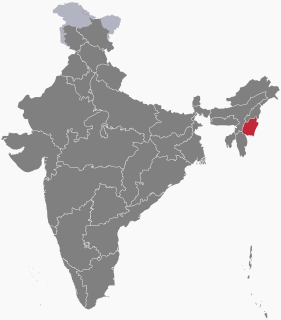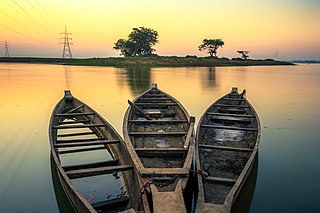Related Research Articles

Assamese, also Asamiya, is an Indo-Aryan language spoken mainly in the north-east Indian state of Assam, where it is an official language, and it serves as a lingua franca of the wider region. The easternmost Indo-Iranian language, it has over 23 million speakers.

Meitei, also known as Manipuri, is a Tibeto-Burman language of north-eastern India. It is spoken by around 1.8 million people, predominantly in the state of Manipur, but also by smaller communities in the rest of the country and in parts of neighbouring Myanmar and Bangladesh. It is native to the Meitei people, and within Manipur it serves as an official language and a lingua franca. It was used as a court language in the historic Manipur Kingdom and is presently included among the 22 scheduled languages of India.

Sylheti is an Indo-Aryan language spoken by an estimated 11 million people, primarily in the Sylhet Division of Bangladesh, the Barak Valley and Hojai district of Assam, and North Tripura and Unakoti district of Tripura, India. Besides, there are substantial numbers of Sylheti speakers in the Indian states of Meghalaya, Manipur and Nagaland as well as diaspora communities in the United Kingdom, the United States, Canada and the Middle East.

Kamarupi Prakrit is the postulated Middle Indo-Aryan (MIA) Prakrit language used in ancient Kamarupa. This language is the historical ancestor of the Kamatapuri lects and the modern Assamese language; and can be dated prior to 1250 CE, when the proto-Kamta language, the parent of the Kamatapuri lects, began to develop. Though not substantially proven, the existence of the language that predated the Kamatapuri lects and modern Assamese is widely believed.

The Assamese alphabet is a writing system of the Assamese language and is a part of the Bengali-Assamese script. This script was also used in Assam and nearby regions for Sanskrit as well as other languages such as Bodo, Khasi, Mising, Jaintia etc. It evolved from Kamarupi script. The current form of the script has seen continuous development from the 5th-century Umachal/Nagajari-Khanikargaon rock inscriptions written in an eastern variety of the Gupta script, adopting significant traits from the Siddhaṃ script in the 7th century. By the 17th century three styles of Assamese alphabets could be identified that converged to the standard script following typesetting required for printing. The present standard is identical to the Bengali alphabet except for two letters, ৰ (ro) and ৱ (vo); and the letter ক্ষ (khya) has evolved into an individual consonant by itself with its own phonetic quality whereas in the Bengali alphabet it is a conjunct of two letters.

Kamrup Rural district, or simply Kamrup district, is an administrative district in the state of Assam in India formed by dividing the old Kamrup district into two in the year 2003; other being Kamrup Metropolitan district, named after the region it constitutes. This district, along with Nalbari, Barpeta, Kamrup Metropolitan, Bajali and Baksa districts has been created from the Undivided Kamrup district.

Barpeta is a town in Barpeta district of the state of Assam in India and is district headquarters. The city is located 90 kilometres (56 mi) north west of Guwahati and is one of the major cities in Western Assam. It is also called Satra Nagari of Assam due to the presence of various Vaishnavite Satras in the vicinity.

Nalbari is a town and a municipal board in Nalbari district in the Indian state of Assam. Nalbari town is also the headquarters of Nalbari District. The town is one of many towns covered under the proposed State capital region.

Boro, also called Bodo, is a Sino-Tibetan language spoken primarily by the Boro people of India, Nepal and Bangladesh. It is an official language of the Indian state of Assam, predominantly spoken in the Bodoland Territorial Region. It is also one of the twenty-two languages listed in the Eighth Schedule of the Constitution of India. Since 1975 the language has been written using the Devanagari script. It was formerly written using Latin and Eastern-Nagari scripts. Some scholars have suggested that the language used to have its own now lost script known as Deodhai.
Garo, also referred to by its endonym A•chikku, is a Sino-Tibetan language spoken in India in the Garo Hills districts of Meghalaya, some parts of Assam, and in small pockets in Tripura. It is also spoken in certain areas of the neighbouring Bangladesh. According to the 2001 census, there are about 889,000 Garo speakers in India alone; another 130,000 are found in Bangladesh.

Goalpariya is a group of Indo-Aryan dialects spoken in the Goalpara region of Assam, India. Along with Kamrupi, they form the western group of Assamese dialects. The North Bengali dialect is situated to its west, amidst a number of Tibeto-Burman speech communities. The basic characteristic of the Goalpariya is that it is a composite one into which words of different concerns and regions have been amalgamated. Deshi people speak this language and there are around 20 lakhs people.

Assamese literature is the entire corpus of poetry, novels, short stories, plays, documents and other writings in the Assamese language. It also includes the literary works in the older forms of the language during its evolution to the contemporary form and its cultural heritage and tradition. The literary heritage of the Assamese language can be traced back to the c. 9-10th century in the Charyapada, where the earliest elements of the language can be discerned.

Bengali, generally known by its endonym Bangla, is an Indo-Aryan language native to the Bengal region of South Asia. It is the official, national, and most widely spoken language of Bangladesh and the second most widely spoken of the 22 scheduled languages of India. With approximately 300 million native speakers and another 37 million as second language speakers, Bengali is the fifth most-spoken native language and the seventh most spoken language by total number of speakers in the world. Bengali is the fifth most spoken Indo-European language.
Rameshwar Pathak was an acclaimed Kamrupi Lokgeet singer from Kamrup, Assam, India. He also worked as a teacher in Arya Vidyapeeth Higher Secondary and Multipurpose School, Guwahati from 1963 to 1996.
Kamrupi or Kamarupi may refer to:

Kamrupi dialects are a group of regional dialects of Assamese, spoken in the Kamrup region. It formerly enjoyed prestige status. It is one of two western dialect groups of the Assamese language, the other being Goalpariya. Kamrupi is heterogeneous with three subdialects— Barpetia dialect, Nalbariya dialect and Palasbaria dialect.
Bhattadeva (1558–1638)(অসমীয়া: বৈকুণ্ঠনাথ ভাগৱত ভট্টাচাৰ্য), is acknowledged as the father of Assamese prose. Though Bhaktiratnakar-katha, the Assamese translation of Sankardev's Sanskrit composition Bhaktiratnakar by Gopala Charana Dwija preceded the works of Bhattadeva, Bhattadeva's prose had an influence in the development of a high and dignified style. Bhattadeva's and Gopala Charana Dvija's 16th century works are considered to be the earliest examples of prose in Indian languages. Bhattadeva's erudition in Sanskrit grammar and literature, and his command over the Bhagavata earned him the title of Bhagavata Bhattacharya.

Kamarupi script was the script used in ancient Kamarupa from as early as 5th century to 13th century, from which the modern Assamese script eventually evolved. In the development of the Assamese script, this phase was followed by the medieval and then by the modern Assamese scripts.

The Miya people (মিঞা), also known as Na-Asamiya, refers to the descendants of migrant Muslims from the modern Mymensingh, Rangpur and Rajshahi Divisions, who settled in the Brahmaputra Valley during the British colonisation of Assam in the 20th-century. Their immigration was encouraged by the Colonial British Government from Bengal Province during 1757 to 1942 and the movement continued till 1947.
Nalbariya dialect is a dialect of Assamese language spoken primarily in and around the Nalbari district of Assam. It is one of three of the Kamrupi group of dialects—the others being Barpetia dialect and Palasbariya dialect.
References
- Oja, Deepali (1995). A critical study of Barpeta dialect (Ph.D). Gauhati University. hdl:10603/67822 . Retrieved 1 June 2017.
- Dutta, Birendranath (2003), "Non-standard Forms of Assamese", in Miri, Mrinal (ed.), Linguistic Situation in Northeast India, New Delhi: Concept Publishing Company, pp. 101–110